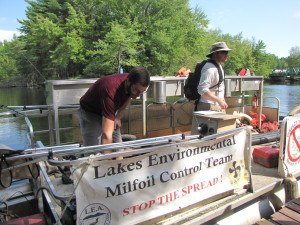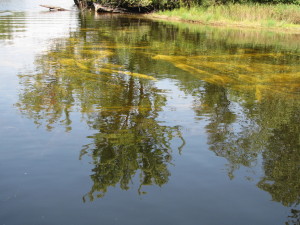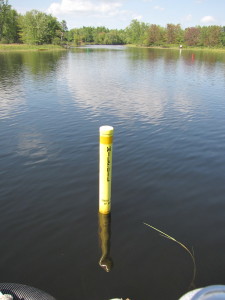Milfoil Success Story on Songo River in Sebago Lakes Region of Maine
Dockside Sports Center Offers Lakefront Property Owners Boat Rentals and More in Rangeley, Maine
August 29, 2013Spend an Old-Fashioned Summer at a Classic Maine Camp on Long Lake, Naples, Maine
September 5, 2013Milfoil Success Story on Songo River in Sebago Lakes Region of Maine
“Milfoil Area” buoy on Songo River near Sebago Lake, Casco, Maine
Many lakefront property owners in the Sebago Lakes Region of Maine travel from Long Lake, through Brandy Pond, down the Songo River to Sebago Lake throughout the summer season. Several years ago, thick stands of the aquatic invasive variable-leaf milfoil (Myriophyllum heterophyllum) crowded out the natives all along the Songo River and spread into both Brandy Pond and Sebago Lake. There was no place in the river channel that wasn’t covered with milfoil.
Lakes Environmental Association (LEA) in Bridgton has incorporated a variety of techniques to fight against the spread of milfoil throughout the region.The main form of reproducing for variable-leaf milfoil is by fragmentation. These shoots are carried downstream by water currents, boats, and waterfowl and spread easily.
Variable-leaf milfoil has a thick, reddish stem covered with whorls of finely-divided leaves. It prefers to grow in relatively calm and shallow (less than 20 feet) waters. The milfoil grows straight up, but in shallower water the stem turns and the plant begins to grow horizontally, thus creating a thick mat. It only takes a small piece of the plant to begin a new population. Milfoil can negatively impact native species, recreation and even property values around infected waterbodies.
Three years ago, sixty percent of the Songo River was covered with variable-leaf milfoil. In some areas there were enormous infestations. Peter Lowell, executive director of LEA, describes it as looking like guts in the water.

Adam Perron, LEA’s invasive plants program coordinator, recently hosted a trip on the river to show Lowell, several LEA board members and John McPhedran of Maine DEP, the work that has been done. Perron and his crew of seven interns use the SS Libra, which houses a Diver Assisted Suction Harvester (DASH) and another small boat to work as teams. The DASH is an efficient method to remove milfoil from the water. It has a suction hose that divers carry into large infestations. While underwater, they harvest milfoil by the roots and feed the material into the suction hose. Milfoil material is then transported through the hose where it is processed aboard the Libra. The DASH unit allows divers to remove large quantities of milfoil while maintaining underwater visibility. For smaller infestations, the divers remove milfoil plants by hand, place the plant material in a mesh bag and carry the bags to the surface. Once harvested, the milfoil is added to compost piles away from the water.

The crew also uses benthic barriers to manage milfoil. Over the years they’ve tried a variety of barrier materials including large tarps and shrink wrap, which they lay on the bottom of the river and secure with stakes. The benthic mats restrict sunlight from the bottom in the areas where they are installed; the absence of sunlight on the substrate restricts the growth of the plants. This is a chemical free form of treating the plants and is reusable. This year another type of barrier has been installed–burlap. Lowell and Perron are curious to see how effective the burlap is over a period of time.

At the state boat launch by Sebago Lake State Park there was a solid band of milfoil two years ago. The crew spent three and a half weeks cleaning up last year’s regrowth and laying fifty tarps in this area. Now there is little to no evidence of the plant. In 2014, they plan to work on the channel that leads from the boat launch to Sebago Lake.
Throughout the season, Perron and his crew survey areas where they have removed plants. The program has been highly successful and they often find either no invasive plants or only a few growing where they were once incredibly dense. Instead, they see that grasses and American waterweed–native aquatic plants–start to take over.
Lowell and McPhedran are extremely impressed with the work that has been completed. Knowing what the river looked like before, they stated that the work the crew has done is phenomenal. Perron explained that every year they focus on certain areas–where people are most likely to travel.
Lowell noted that all the money that has been invested into this program has paid off. He never thought it would be as clean as it is today. “We know now that we can control it,” he said. “This was a real nasty situation.”
Throughout the state, other lake associations have undertaken the similar tasks to control milfoil and other aquatic invasives. As lakefront property owners, we all need to remember that fragments can stow away in boats, trailers and fishing tackle where they could potentially spread to unaffected bodies of water. Yes, it can be controlled, but the cost is high. It’s quite easy, however, to check your boat before and after you float to make sure you aren’t helping spread this and other aquatic invasive plants.
To learn more about lakefront properties for sale on Sebago Lake, click on the green box above.
To learn more about the Sebago Lakes Region, check out the blog links below.
Sebago Lake Region, Windham, Maine: Lakefront Property Highly Valued
The Greater Sebago Lakes Region of Maine

